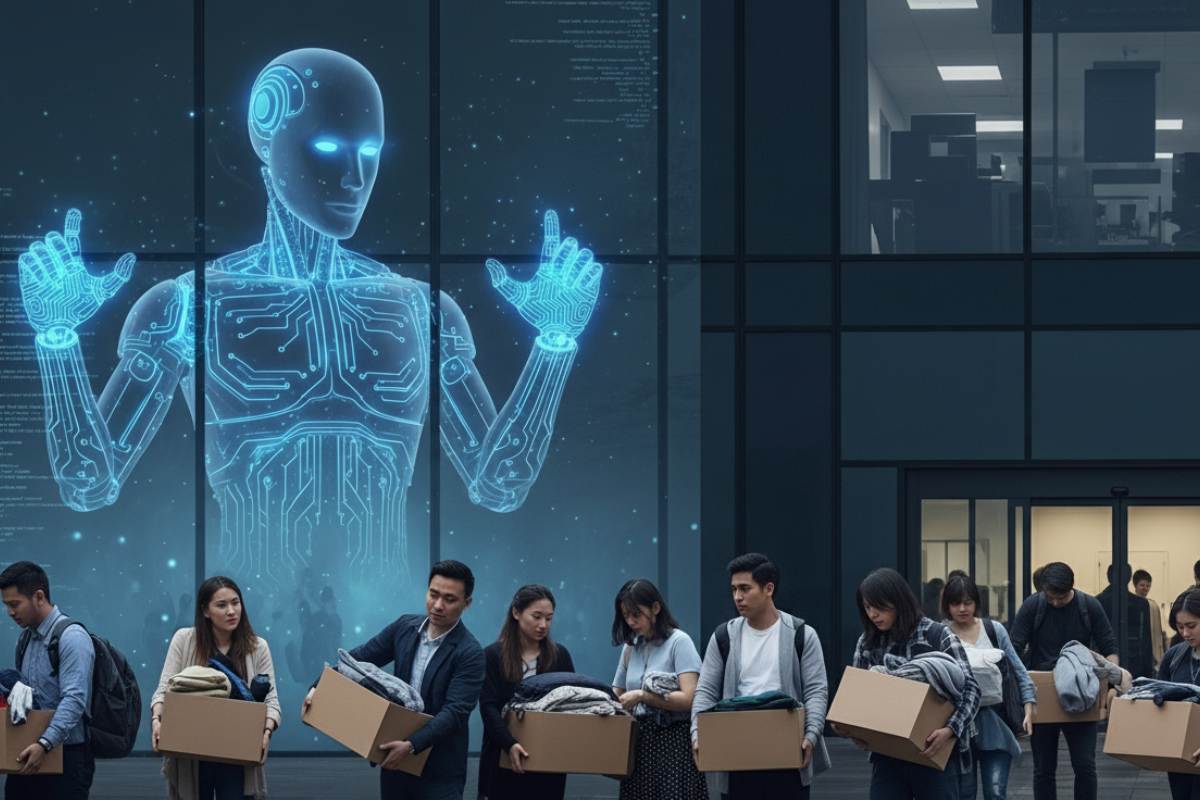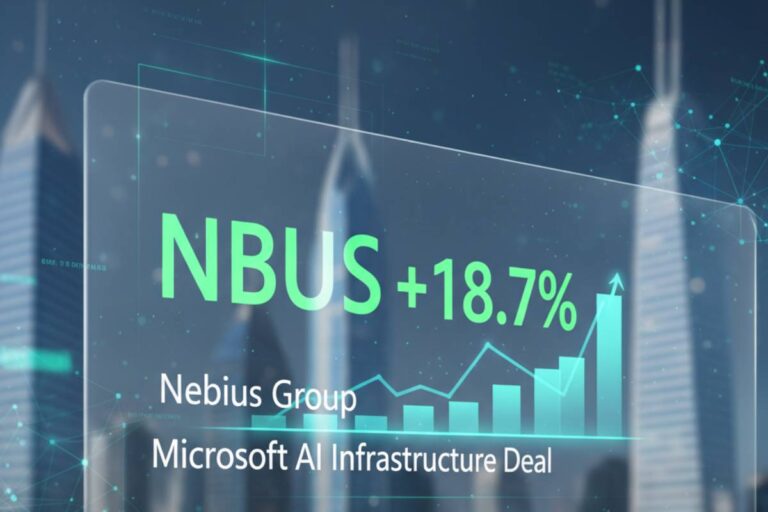Unprecedented Shakeup in Tech Sector
In 2025, the tech sector is going through an unprecedented period. This time, artificial intelligence is actually replacing human workers at an alarming rate, so it’s not just another economic downturn making businesses tighten their belts.
This year, more than 80,000 workers from 176 tech companies have lost their jobs. The worst part is that this wave is essentially different from earlier layoff cycles brought on by market crashes or the aftermath of pandemics. Businesses like Amazon, Microsoft, Meta, and Oracle are laying off employees not because they can no longer pay them, but rather because they no longer need them.
Unprecedented Job Displacement is Being Driven by the AI Revolution
- This isn’t your normal cost-cutting strategy.
- Businesses are taking these actions and investing billions in AI infrastructure at the same time.
- Despite laying off more than 15,000 employees worldwide since May, Microsoft alone has spent more than $80 billion on AI development in the last year.
In June, Amazon CEO Andy Jassy stated quite bluntly that as the company increases its use of automated agents and generative AI, it will require “fewer people doing some of the jobs that are being done today.” That’s business jargon for: routine tasks are being replaced by machines more quickly than we anticipated.
Not all tech jobs are being equally impacted by this. While traditional positions in middle management, software development, and customer service are being eliminated, there is an unprecedented demand for cloud engineers, cybersecurity experts, and AI specialists.
Microsoft: Setting the Standard with Significant Staff Reductions
Microsoft is the quintessential example of AI-driven downsizing.
- Over 15,000 employees laid off in several rounds this year.
- May cuts impacted 6,000 workers; July affected another 9,000.
What is especially telling? Product teams, engineering, sales, marketing, and even the Xbox division have all been impacted by these layoffs. Microsoft is reorganizing entire business units around AI capabilities rather than merely cutting fat.
The company’s approach seems clear: make significant investments in AI infrastructure while lowering reliance on the human workforce. The idea that automation will outperform conventional human-driven processes in terms of efficiency is a calculated risk.
Meta’s Selective Method: The Transition to Performance-Based AI
- In February, Meta laid off more than 3,000 workers.
- Cuts were framed around performance standards, not just automation, by CEO Mark Zuckerberg.
- Vigorous hiring campaign launched for Meta Superintelligence Labs.
- Focus mainly on underachievers, while AI talent is highly valued.
Meta’s dual strategy – employing AI experts while reducing current staff – shows how talent pools are being reshaped. Traditional jobs are going extinct, but high-end AI jobs now pay millions of dollars.
Zuckerberg’s message was very clear: as Meta navigates the AI transformation, it is increasing workforce performance standards. Those who are unable to adjust to workflows enhanced by AI will not be selected.
Amazon’s AI-First Restructuring Strategy
Amazon has taken a drastic but no less important approach.
- Hundreds of employees cut across Wondery podcast division, books and devices division, and AWS cloud computing.
- Positions eliminated include administrative, middle management, software development, and customer service representatives.
These are precisely the tasks that automation and artificial intelligence outperform people. AWS, Amazon’s cloud division, continues to be a crucial battlefield against rivals like Microsoft Azure. Even if it means fewer human employees managing those services, Amazon is betting big on AI-powered services.
Restructuring Oracle’s Global Cloud Division
Oracle’s layoffs have been especially severe.
- More than 3,000 jobs lost globally.
- Impact across the US, India, Canada, Europe.
- At least 254 jobs eliminated in the San Francisco Bay Area, and 101 in Seattle.
Focusing on cloud and AI infrastructure, Oracle is eliminating roles that no longer support its strategy, affecting departments such as marketing, corporate divisions, software development, and cloud infrastructure.
This all-encompassing strategy means Oracle is radically rethinking how its company runs in an AI-first world, not just optimizing particular tasks.
Salesforce: AI Agents Take the Place of Human Customer Service
Salesforce is perhaps the best illustration of AI directly replacing human labor.
- Customer support division now employs 5,000 instead of 9,000 after cutting 4,000 jobs.
- More than a million customer conversations handled by AI agents.
Machines solving customer issues more quickly and reliably than humans change the logic for maintaining large support teams. Salesforce executives call this “agentic AI,” increasing efficiency and automation.
To the 4,000 displaced workers, it’s a clear sign of how rapidly AI can make whole job categories obsolete.
TCS and Its Effect on IT Services Worldwide
Not just American tech giants – India’s Tata Consultancy Services (TCS) is making cuts too.
- Plans to lay off about 12,000 workers worldwide in fiscal year 2025–2026.
- Mostly mid-level and senior employees (roughly 2% of the workforce).
- Driven by “skill mismatches amid technological changes,” not just cost.
TCS’s decision shows how deeply the global tech ecosystem is impacted by AI. Even companies that thrived by staffing tech projects are automating those same services.
For impacted employees, the company has promised severance, support, and reskilling. Yet, traditional IT service roles are becoming outdated more quickly than businesses can retrain their workforce.
The Roles Most at Risk from Automation by AI
Layoffs reveal which jobs are most vulnerable:
- Customer Service Representatives
AI chatbots and virtual agents answer routine inquiries 24/7 without breaks or pay. - Software Developers
Automated coding tools and AI programming assistants reduce need for junior/mid-level developers. - System Analysts
Network and server maintenance increasingly relies on self-healing, automated systems. - Project Managers
AI tools coordinate workflows and track progress for routine projects – less human oversight needed. - Database Administrators
Cloud computing and AI simplify database management, making human involvement less vital. - Middle Management
As AI takes over basic decision-making, scheduling, and reporting, administrative coordination roles can disappear.
New Prospects in the AI-Powered Technology Sector
As traditional tech jobs disappear, several roles see fast growth:
- AI Experts
Design, develop, and administer AI systems – highly sought. - Machine Learning Engineers
Work with data and algorithms – critical for competitive edge. - Cybersecurity Specialists
Security experts are always needed as digital threats evolve. - Cloud Engineers
Platforms like AWS, Azure, Google Cloud still need specialized technical roles. - Medical Technology
AI and healthcare together offer new career opportunities.
The Human Price of Business Strategy
Behind these statistics, real people face uncertain futures.
- Court filings show layoffs hit workers in various departments and areas.
- Whole teams in India and the Philippines have been eliminated.
- AI-focused restructuring is a global phenomenon – Silicon Valley to Bangalore.
For displaced workers, getting AI-relevant skills is harder than just finding a new job. Tech career paths are shifting faster than education systems can keep up.
Industry Professionals Comment on the Shift
According to a World Economic Forum survey:
- 41% of businesses globally expect to lay off employees in the next five years due to AI.
- Not a short-term fix – this is a fundamental change.
The survey says AI-driven job loss is just beginning. Despite cautious forecasts, as AI advances, workforce reductions look set to continue.
By 2030, tech jobs in fintech, AI, and big data are predicted to double. For workers, the challenge is bridging the gulf between vanishing traditional roles and emerging, AI-focused positions.
Impact by Region: The Reaction of Various Markets
Regional impacts from layoffs:
- United States:
Legal frameworks used to manage major workforce reductions, while investing in AI infrastructure. - India:
IT companies automating traditional outsourcing, affecting hundreds of thousands of workers. - Europe:
AI-driven layoffs slowed by stricter labor laws, but companies restructure via attrition or fewer hires. - Philippines:
AI is cutting jobs in call centers and customer service.
Such regional variations reflect how business culture, economics, and labor laws affect AI adoption and workforce transition plans.
Implications for Upcoming Tech Careers
For tech careers, the 2025 layoffs mark a turning point. Incoming workers should focus on skills that enhance, not compete with, AI:
- Creative Problem-Solving
AI handles routine work but struggles with novel, creative challenges. - Emotional Intelligence
Empathy and social skills are still key for managing teams and clients. - Strategic Thinking
Humans still have to make tough, complex choices with long-term consequences. - AI Collaboration
Value lies in working with – understanding the strengths and limits of – AI.
The Wider Economic Consequences
These layoffs aren’t isolated. They’re part of a larger trend toward AI-driven productivity gains.
- Short-term workforce reduction
- Long-term efficiency improvement
But… social and economic problems loom. Major employers cutting staff in sync could hit regional economies hard. Cities depending on tech may need to diversify as those jobs get scarce.
Previous tech revolutions took decades; AI change is coming in years, not generations.
Looking Ahead: What Will Happen to Tech Jobs Next?
Current AI-triggered layoffs may be just phase one. As AI gets better, more job categories will feel the automation squeeze.
Successful companies will balance efficiency with human capital. Retraining and upskilling foster innovation and adaptability beyond simple worker replacement.
How tech tackles this challenge shapes how other industries transition too. Manufacturing, finance, healthcare, and education are all watching this closely.
For employees, the message is blunt: adaptability and lifelong learning aren’t bonus skills – they’re essential. Jobs of the future may not exist yet, but those who can roll with the technological punches will thrive.
The 2025 tech layoffs signal a huge shift in human-AI collaboration. Whether AI leads to greater inequality or a shared prosperity – that’s the big question going forward.
















